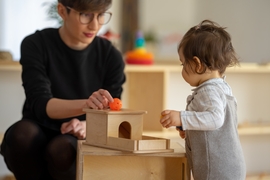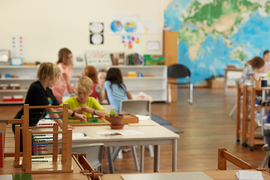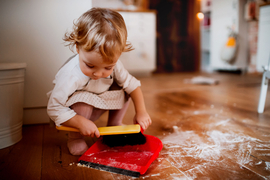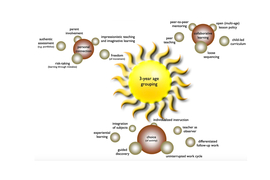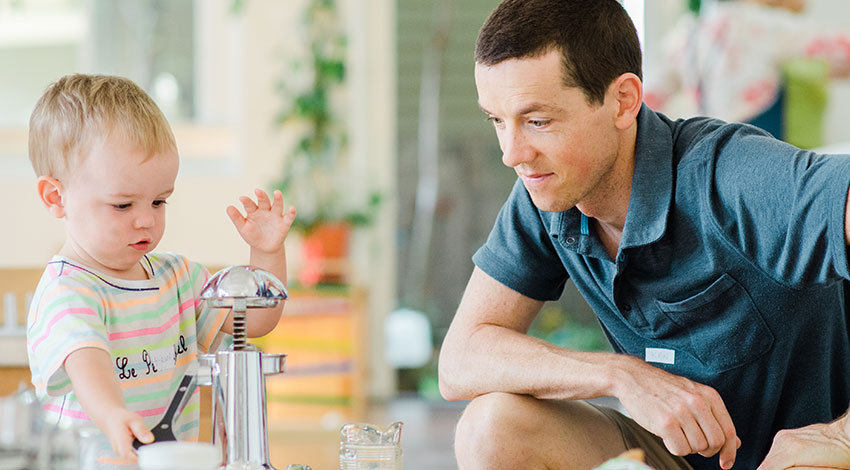
In Montessori Education, the specially designed place that children come to work in is called a ‘prepared learning environment’. The first ‘work’ your child will do in the program is to orientate themselves to the new space in which they find themselves, which may take a couple of sessions.
The space will be arranged in exactly the same way each week in order to assist this orientation process. Each area in the ‘environment’ has a specific order and contains activities or ‘materials’ which serve different purposes for your child’s development.
The focus for this age group are Practical Life activities - the activities we all do every day to take care of ourselves (including preparing food) and the spaces we live in. These activities and the way in which we do them, are rooted in our culture.
Practical Life activities are aided by movement development. As a child gains more movement possibilities their ability to accomplish these activities becomes more refined, until bit by bit they are able to do the activities by themselves.
Practical Life activities meet key developmental needs for children from 0-6 years old.
These activities enable the child:
- To build the child’s conceptual base about real life
- To co-ordinate and refine purposeful, fine and gross movement skills
- To repeat movements - this builds concentrations
- To practice sequencing a number of steps
- To develop the ‘Will’ through making choices based on knowledge.
- To develop the vocabulary
- To grow in independence and REAL self-esteem
- To adapt to or become a member of a culture
- To aid in physical and mental integration:
When we present an activity to the child, we feed the INTELLECT, when the child makes a choice about doing an activity, we have fed their WILL and when they choose to do the activity, they enhance their MOVEMENT ability.
The materials presented to the children in this environment are known as psycho-sensory materials. These materials serve your child by supporting:
- Refinement of the Grasp – from four fingers opposing the thumb through to a refined pincer grasp.
- Eye-to-hand Co-ordination – the control of the hands’ movement by the mind.
We also have physical language materials to support provide additional vocabulary and enjoyable language based experiences for young children:
1. Classified Objects – real and replica. Build the child’s association with vocabulary by providing lots of sensorial information from the manipulation objects.
2. Objects with Matching Cards - Enable the child to begin learning that a 2 dimensional picture can represent all the characteristics of a 3 dimensional object.
3. Nomenclature Cards - Provide vocabulary for things that we cannot provide objects for in the environment.
Children are drawn to the painting, drawing, clay work and music in our environment through their need for self-expression. Predictable developmental patterns have been observed in young children’s drawing and painting, which relate to their stage of neurological development. Rhoda Kellogg’s work looked at basic drawing or scribble patterns in different stages of children’s development. These are displayed in our environment.
Our focus is upon the child’s developmental process via these activities, rather than upon the product or output of their work.
When we provide feedback to children about their artwork on a day-to-day basis, we want to honour the process the child has undergone in producing the work. We can encourage and respond to a child’s request for approval by making comments based on our observation e.g. ‘You used a lot of red paint today’, ‘You spent a long time on that piece of work’, ‘Do you like it?
This enables the child to place their own value on their work, rather than have that value dictated to them by the adult.
Working with your Child in the Montessori Parent and Toddler Program
Materials increase in complexity or challenge from left to right, with the simplest materials on the highest shelf.
All the materials are designed so that the child can use them with as little adult assistance as possible. Initially you may need to collaborate with your child, but ultimately they will be able to use them independently. Some materials, particularly the Practical Life materials, have many parts and involve complex movements and the Montessori Guide will ‘present’ these materials to your child so that you can both learn how to use them.
As long as your child is does not harm themselves, other people or the environment, they are free to choose whichever materials look interesting and use them in whichever way works for them. There are no ‘mistakes’ here, only learning opportunities!
When working with your child, we focus upon promoting:
- Repetition
- Undisturbed concentration
- Encourage your child to take the material to a table and sit down to work.
- If your child begins purposeful and concentrated work at the shelf, this is fine.
- If your child is using the material unsafely (e.g. throwing things) put your hands on their hands and say ‘Stop, my turn, watch.’ Without providing further verbal instructions, slowly show your child how they can use the material.
- The next lesson is to encourage your child to put the material back on the shelf in its correct place.
If you child leaves a material out and has already engaged with another material, let them work and put the first material away for them.
